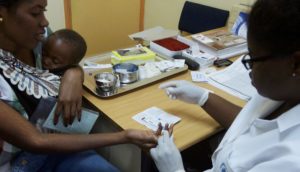Segmenting, Prioritizing and Profiling Key Audiences
 For service communication activities to be successful, you must segment your audiences into similar groups and gain a deep understanding of those audiences. This is the first step you will take before designing or implementing any activities. You will select the primary and secondary audiences you need to work with to achieve your goals.
For service communication activities to be successful, you must segment your audiences into similar groups and gain a deep understanding of those audiences. This is the first step you will take before designing or implementing any activities. You will select the primary and secondary audiences you need to work with to achieve your goals.
The primary audience is the individual or individuals who are directly affected and whom the program wants to practice the desired behavior (for example, women of reproductive age, urban youth, male heads of household). Primary audiences may also be the people who can make decisions on behalf of those who would benefit from the behavior (for example, caregivers of children under 5). The secondary audience – individuals who exert influence – are people who can guide behaviors of the primary audience (for example, spouses, parents, peers and coworkers). Secondary audiences can also include people who shape norms, influence policies or affect how people think about the behavior (for example, the media, traditional leaders and local opinion leaders).
The intended audience for services could include a number of different types of individuals, and may differ throughout the three stages of service delivery. For example:
- Before: When seeking to increase demand for HIV testing, the audience may include female sex workers in urban areas.
- During: Providers may be the intended audience for behavior change to motivate them to provide high-quality counseling on informed choice.
- After: The client and the client’s peers may comprise the intended audience, with the objective of helping the client maintain consistent use of family planning methods and encourage social support.
This section walks through audience analysis – the step-by-step process for understanding the intended audience.
Why Is Audience Analysis Important to Service Communication?
An audience analysis helps establish a detailed and realistic picture of the audience. A good audience analysis ensures that messages and activities realistically reflect and address the audience’s values, desires and barriers to change. Messages informed by this analysis are more likely to resonate with the audience, leading to the desired behavior change and better outcomes. Audience analysis should be conducted at the beginning of the program, before any communication activities are developed.
To some extent, audience analysis is similar to something that is done regularly in service delivery programs. For example, in developing a training program to build clinical skills, many programs assess providers’ existing capacity to determine training needs. This assessment often identifies categories of providers, based on their current skills and knowledge. The results of the assessment help ensure that training and capacity building resources are allocated based on need. A similar principle applies for audience analyses for service communication.
What Is the Audience Analysis Process?
An audience analysis is a multi-step process that begins with data and results in a description of the intended audience summarized in an “audience profile.” The audience analysis process typically identifies a primary audience (the individuals whose behavior the program seeks to motivate) and the secondary or influencing audience (the individuals who have influence over the primary audience in whether they are able to adopt and maintain new behaviors). For example, a program seeking to increase uptake of adolescent reproductive health services may determine that there are a limited number of high-quality clinical services dedicated to adolescents. The program identifies young people ages 10-18 as the primary audience. It also identifies different influencing audiences for each stage.
As a result, communication during the before services stage will concentrate on advocacy to influence policymakers or leaders in the Reproductive Health Division of the Ministry of Health who can allocate more resources for adolescent health services. In the during stage, the program will train service providers to improving counseling techniques for adolescent clients and providers, and in the after stage, the program may focus community mobilization on the peers or parents who enable adolescents to maintain positive reproductive health behaviors.
The audience analysis process has four main steps:

